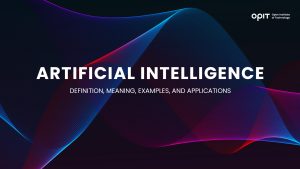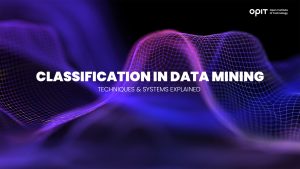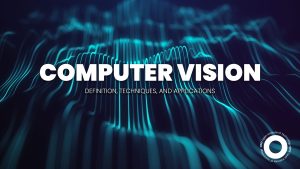
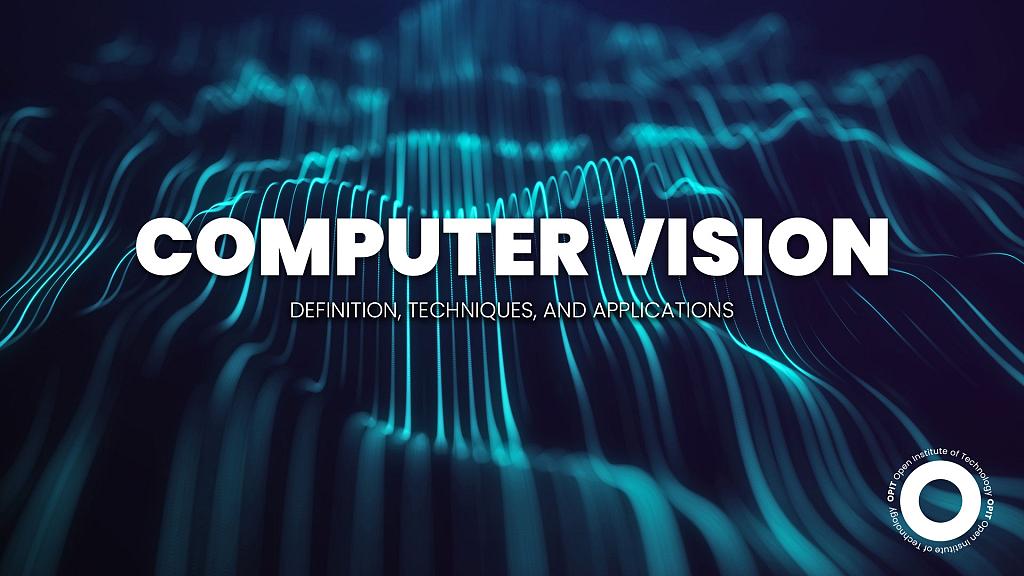
For most people, identifying objects surrounding them is an easy task.
Let’s say you’re in your office. You can probably casually list objects like desks, computers, filing cabinets, printers, and so on. While this action seems simple on the surface, human vision is actually quite complex.
So, it’s not surprising that computer vision – a relatively new branch of technology aiming to replicate human vision – is equally, if not more, complex.
But before we dive into these complexities, let’s understand the basics – what is computer vision?
Computer vision is an artificial intelligence (AI) field focused on enabling computers to identify and process objects in the visual world. This technology also equips computers to take action and make recommendations based on the visual input they receive.
Simply put, computer vision enables machines to see and understand.
Learning the computer vision definition is just the beginning of understanding this fascinating field. So, let’s explore the ins and outs of computer vision, from fundamental principles to future trends.
History of Computer Vision
While major breakthroughs in computer vision have occurred relatively recently, scientists have been training machines to “see” for over 60 years.
To do the math – the research on computer vision started in the late 1950s.
Interestingly, one of the earliest test subjects wasn’t a computer. Instead, it was a cat! Scientists used a little feline helper to examine how their nerve cells respond to various images. Thanks to this experiment, they concluded that detecting simple shapes is the first stage in image processing.
As AI emerged as an academic field of study in the 1960s, a decade-long quest to help machines mimic human vision officially began.
Since then, there have been several significant milestones in computer vision, AI, and deep learning. Here’s a quick rundown for you:
- 1970s – Computer vision was used commercially for the first time to help interpret written text for the visually impaired.
- 1980s – Scientists developed convolutional neural networks (CNNs), a key component in computer vision and image processing.
- 1990s – Facial recognition tools became highly popular, thanks to a shiny new thing called the internet. For the first time, large sets of images became available online.
- 2000s – Tagging and annotating visual data sets were standardized.
- 2010s – Alex Krizhevsky developed a CNN model called AlexNet, drastically reducing the error rate in image recognition (and winning an international image recognition contest in the process).
Today, computer vision algorithms and techniques are rapidly developing and improving. They owe this to an unprecedented amount of visual data and more powerful hardware.
Thanks to these advancements, 99% accuracy has been achieved for computer vision, meaning it’s currently more accurate than human vision at quickly identifying visual inputs.
Fundamentals of Computer Vision
New functionalities are constantly added to the computer vision systems being developed. Still, this doesn’t take away from the same fundamental functions these systems share.
Image Acquisition and Processing
Without visual input, there would be no computer vision. So, let’s start at the beginning.
The image acquisition function first asks the following question: “What imaging device is used to produce the digital image?”
Depending on the device, the resulting data can be a 2D, 3D image, or an image sequence. These images are then processed, allowing the machine to verify whether the visual input contains satisfying data.
Feature Extraction and Representation
The next question then becomes, “What specific features can be extracted from the image?”
By features, we mean measurable pieces of data unique to specific objects in the image.
Feature extraction focuses on extracting lines and edges and localizing interest points like corners and blobs. To successfully extract these features, the machine breaks the initial data set into more manageable chunks.
Object Recognition and Classification
Next, the computer vision system aims to answer: “What objects or object categories are present in the image, and where are they?”
This interpretive technique recognizes and classifies objects based on large amounts of pre-learned objects and object categories.
Image Segmentation and Scene Understanding
Besides observing what is in the image, today’s computer vision systems can act based on those observations.
In image segmentation, computer vision algorithms divide the image into multiple regions and examine the relevant regions separately. This allows them to gain a full understanding of the scene, including the spatial and functional relationships between the present objects.
Motion Analysis and Tracking
Motion analysis studies movements in a sequence of digital images. This technique correlates to motion tracking, which follows the movement of objects of interest. Both techniques are commonly used in manufacturing for monitoring machinery.
Key Techniques and Algorithms in Computer Vision
Computer vision is a fairly complex task. For starters, it needs a huge amount of data. Once the data is all there, the system runs multiple analyses to achieve image recognition.
This might sound simple, but this process isn’t exactly straightforward.
Think of computer vision as a detective solving a crime. What does the detective need to do to identify the criminal? Piece together various clues.
Similarly (albeit with less danger), a computer vision model relies on colors, shapes, and patterns to piece together an object and identify its features.
Let’s discuss the techniques and algorithms this model uses to achieve its end result.
Convolutional Neural Networks (CNNs)
In computer vision, CNNs extract patterns and employ mathematical operations to estimate what image they’re seeing. And that’s all there really is to it. They continue performing the same mathematical operation until they verify the accuracy of their estimate.
Deep Learning and Transfer Learning
The advent of deep learning removed many constraints that prevented computer vision from being widely used. On top of that, (and luckily for computer scientists!), it also eliminated all the tedious manual work.
Essentially, deep learning enables a computer to learn about visual data independently. Computer scientists only need to develop a good algorithm, and the machine will take care of the rest.
Alternatively, computer vision can use a pre-trained model as a starting point. This concept is known as transfer learning.
Edge Detection and Feature Extraction Techniques
Edge detection is one of the most prominent feature extraction techniques.
As the name suggests, it can identify the boundaries of an object and extract its features. As always, the ultimate goal is identifying the object in the picture. To achieve this, edge detection uses an algorithm that identifies differences in pixel brightness (after transforming the data into a grayscale image).
Optical Flow and Motion Estimation
Optical flow is a computer vision technique that determines how each point of an image or video sequence is moving compared to the image plane. This technique can estimate how fast objects are moving.
Motion estimation, on the other hand, predicts the location of objects in subsequent frames of a video sequence.
These techniques are used in object tracking and autonomous navigation.
Image Registration and Stitching
Image registration and stitching are computer vision techniques used to combine multiple images. Image registration is responsible for aligning these images, while image stitching overlaps them to produce a single image. Medical professionals use these techniques to track the progress of a disease.
Applications of Computer Vision
Thanks to many technological advances in the field, computer vision has managed to surpass human vision in several regards. As a result, it’s used in various applications across multiple industries.
Robotics and Automation
Improving robotics was one of the original reasons for developing computer vision. So, it isn’t surprising this technique is used extensively in robotics and automation.
Computer vision can be used to:
- Control and automate industrial processes
- Perform automatic inspections in manufacturing applications
- Identify product and machine defects in real time
- Operate autonomous vehicles
- Operate drones (and capture aerial imaging)
Security and Surveillance
Computer vision has numerous applications in video surveillance, including:
- Facial recognition for identification purposes
- Anomaly detection for spotting unusual patterns
- People counting for retail analytics
- Crowd monitoring for public safety
Healthcare and Medical Imaging
Healthcare is one of the most prominent fields of computer vision applications. Here, this technology is employed to:
- Establish more accurate disease diagnoses
- Analyze MRI, CAT, and X-ray scans
- Enhance medical images interpreted by humans
- Assist surgeons during surgery
Entertainment and Gaming
Computer vision techniques are highly useful in the entertainment industry, supporting the creation of visual effects and motion capture for animation.
Good news for gamers, too – computer vision aids augmented and virtual reality in creating the ultimate gaming experience.
Retail and E-Commerce
Self-check-out points can significantly enhance the shopping experience. And guess what can help establish them? That’s right – computer vision. But that’s not all. This technology also helps retailers with inventory management, allowing quicker detection of out-of-stock products.
In e-commerce, computer vision facilitates visual search and product recommendation, streamlining the (often frustrating) online purchasing process.
Challenges and Limitations of Computer Vision
There’s no doubt computer vision has experienced some major breakthroughs in recent years. Still, no technology is without flaws.
Here are some of the challenges that computer scientists hope to overcome in the near future:
- The data for training computer vision models often lack in quantity or quality.
- There’s a need for more specialists who can train and monitor computer vision models.
- Computers still struggle to process incomplete, distorted, and previously unseen visual data.
- Building computer vision systems is still complex, time-consuming, and costly.
- Many people have privacy and ethical concerns surrounding computer vision, especially for surveillance.
Future Trends and Developments in Computer Vision
As the field of computer vision continues to develop, there should be no shortage of changes and improvements.
These include integration with other AI technologies (such as neuro-symbolic and explainable AI), which will continue to evolve as developing hardware adds new capabilities and capacities that enhance computer vision. Each advancement brings with it the opportunity for other industries (and more complex applications). Construction gives us a good example, as computer vision takes us away from the days of relying on hard hats and signage, moving us toward a future in which computers can actively detect, and alert site foremen too, unsafe behavior.
The Future Looks Bright for Computer Vision
Computer vision is one of the most remarkable concepts in the world of deep learning and artificial intelligence. This field will undoubtedly continue to grow at an impressive speed, both in terms of research and applications.
Are you interested in further research and professional development in this field? If yes, consider seeking out high-quality education in computer vision.
Related posts

Source:
- Times of Malta, published on September 18th, 2025
4 min read
The gathering brought together academics and technology leaders from prominent European Institutions, such as Instituto de Empresa (IE University), OPIT itself and the Royal College of Arts, to explore how artificial intelligence is reshaping the university experience.
The OPIT AI Copilot has been trained on the institute’s complete academic archive, a collection created over the past three years that includes 131 courses, more than 3,500 hours of recorded lectures, 7,500 study resources, 320 certified assessments, and thousands of exercises and original learning documents.
Unlike generic AI tools, the Copilot is deeply integrated with OPIT’s learning management system, allowing it to track each student’s progress and provide tailored support.
This integration means the assistant can reference relevant sources within the learning environment, adapt to the student’s stage of study, and ensure that unreleased course content remains inaccessible.
A mobile app is also scheduled for release this autumn, that will allow students to download exercise and access other tools.
During examinations, the Copilot automatically switches to what the institute calls an “anti-cheating mode”, restricting itself to general research support rather than providing direct answers.
For OPIT’s international community of 500 students from nearly 100 countries, many of whom balance studies with full-time work, the ability to access personalised assistance at any time of day is a key advantage.
“Eighty-five per cent of students are already using large language models in some way to study,” said OPIT founder and director Riccardo Ocleppo. “We wanted to go further by creating a solution tailored to our own community, reflecting the real experiences of remote learners and working professionals.”
Tool aims to cut correction time by 30%
The Copilot will also reduce administrative burdens for faculty. It can help grade assignments, generate new educational materials, and create rubrics that allow teachers to cut correction time by as much as 30 per cent.
According to OPIT, this will free up staff to dedicate more time to teaching and direct student engagement.
At the Milan event, Rector Francesco Profumo underlined the broader implications of AI in higher education. “We are in the midst of a deep transformation, where AI is no longer just a tool: it is an environment that radically changes how we learn, teach, and create,” he said.
“But it is not a shortcut. It is a cultural, ethical, and pedagogical challenge, and to meet it we must have the courage to rethink traditional models and build bridges between human and artificial intelligence.”
OPIT was joined on stage by representatives from other leading institutions, including Danielle Barrios O’Neill of the Royal College of Art, who spoke about the role of AI in art and creativity, and Francisco Machin of IE University, who discussed applications in business and management education.
OPIT student Asya Mantovani, also employed at a leading technology and consulting firm in Italy, gave a first-hand account of balancing professional life with online study.
The assistant has been in development for the past eight months, involving a team of OPIT professors, researchers, and engineers.
Ocleppo stressed that OPIT intends to make its AI innovations available beyond its own institution. “We want to put technology at the service of higher education,” he said.
“Our goal is to develop solutions not only for our own students, but also to share with global institutions eager to innovate the learning experience in a future that is approaching very quickly.”
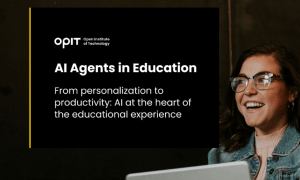
From personalization to productivity: AI at the heart of the educational experience.
Click this link to read and download the e-book.
At its core, teaching is a simple endeavour. The experienced and learned pass on their knowledge and wisdom to new generations. Nothing has changed in that regard. What has changed is how new technologies emerge to facilitate that passing on of knowledge. The printing press, computers, the internet – all have transformed how educators teach and how students learn.
Artificial intelligence (AI) is the next game-changer in the educational space.
Specifically, AI agents have emerged as tools that utilize all of AI’s core strengths, such as data gathering and analysis, pattern identification, and information condensing. Those strengths have been refined, first into simple chatbots capable of providing answers, and now into agents capable of adapting how they learn and adjusting to the environment in which they’re placed. This adaptability, in particular, makes AI agents vital in the educational realm.
The reasons why are simple. AI agents can collect, analyse, and condense massive amounts of educational material across multiple subject areas. More importantly, they can deliver that information to students while observing how the students engage with the material presented. Those observations open the door for tweaks. An AI agent learns alongside their student. Only, the agent’s learning focuses on how it can adapt its delivery to account for a student’s strengths, weaknesses, interests, and existing knowledge.
Think of an AI agent like having a tutor – one who eschews set lesson plans in favour of an adaptive approach designed and tweaked constantly for each specific student.
In this eBook, the Open Institute of Technology (OPIT) will take you on a journey through the world of AI agents as they pertain to education. You will learn what these agents are, how they work, and what they’re capable of achieving in the educational sector. We also explore best practices and key approaches, focusing on how educators can use AI agents to the benefit of their students. Finally, we will discuss other AI tools that both complement and enhance an AI agent’s capabilities, ensuring you deliver the best possible educational experience to your students.
Have questions?
Visit our FAQ page or get in touch with us!
Write us at +39 335 576 0263
Get in touch at hello@opit.com
Talk to one of our Study Advisors
We are international
We can speak in:

